|
|

This chapter provides examples of R2 signaling that use the following call control elements:
Two examples discuss R2 digit collections on incoming trunks (calls coming into the VCO/4K system); a third example describes R2 digit outpulsing on outgoing trunks (calls originating at the VCO/4K system). Each example begins with a brief explanation of the scenario, followed by a graphic representation of the call flow. These diagrams illustrate system processing and information flow between the VCO/4K system and host, and between the VCO/4K system and connected equipment (network registers). Direction of the information flow is indicated by arrows under the message data.
MFCR2 outpulse rule tokens include the following tones:
Group B tones are also sent in response to Group II tones once a changeover to the reception of Group B signal request is successfully completed.
These tones correspond to Category and Fields in the following manner.
The Group B tones, as well as tone A-6, indicate a terminal status and complete the register signaling dialogue. Pulsed transmission of A-4 indicates a busy state. Receiving tones B-2, B-3, B-4, B-5, B-8, or A-4 cause the system to fail the call attempt.
Example #1 illustrates a simple R2 digit collection scenario after an incoming seize on the VCO/4K system E1 circuit at port address $00 61. A Venezuela specific inpulse rule is executed to perform R2 digit collection on this circuit.
The inpulse rule performs the following general tasks:
At the end of this example, the system establishes speech conditions with the connected equipment (network register) and generates an Inpulse Rule Complete ($DD) report to the host. The processing flow for this example is shown in Figure 4-1. In this example, it is assumed that the Venezuela specific inpulse rule for the incoming circuit has been defined as inpulse rule #1 (shown below).
RULE #1 |
|
|
|
|
|
|
|
|
|
|
|
|
|
|
|
|
|
Refer to the Cisco VCO/4K System Administrator's Guide for more information about specific MFCR2 inpulse rule tokens.
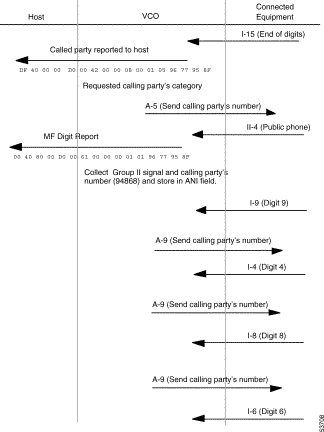


Example #2 also illustrates a simple R2 digit collection scenario on an incoming E1 circuit (port address $00 61). However, all R2 digit collections in this scenario are initiated by host command; no inpulse rule processing is used. Three MF Collection Control ($68) commands perform the following actions.
An MF Digit ($D0) report reports each digit collection to the host.
At the end of this example, the system establishes speech conditions with the connected equipment (network register). The processing flow for this example is shown in Figure 4-4.
Refer to the Cisco VCO/4K Standard Programming Reference and the Cisco VCO/4K Extended Programming Reference for more information about the $68 command and the $D0 report.
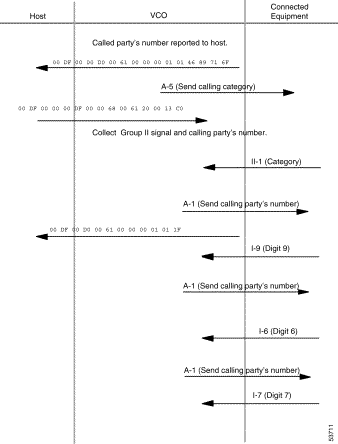

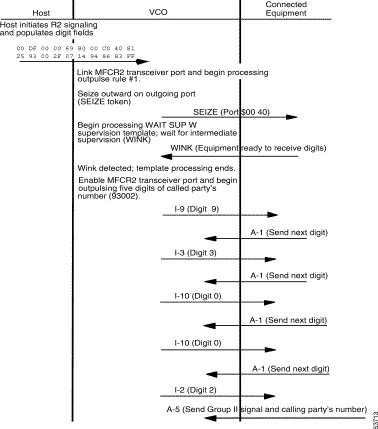
Example #3 describes R2 digit outpulsing on an E1 circuit at port address $00 40. This scenario involves both host command and outpulse rule processing. The host initiates the outpulsing using an Outgoing Port Control ($69) command that populates the digit fields and specifies the outpulse rule to execute (refer to the Cisco VCO/4K Standard Programming Reference or the Cisco VCO/4K Extended Programming Reference for a command description).
The outpulse rule performs the following actions.
This rule is shown below.
RULE #1 |
|
|
|
|
|
|
|
At the end of this example, the system establishes speech conditions with the connected equipment (network register) and generates an Outgoing Port Change of State ($DA) report to the host indicating the final backward digit. The processing flow for this example is shown in Figure 4-7 through Figure 4-9.
Refer to the Cisco VCO/4K System Administrator's Guide for more information about OP MFCR2, OP ANI, OP FIELD [xx], and OP CAT [xx] outpulse rule tokens.
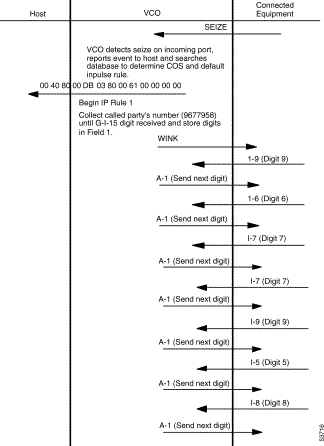
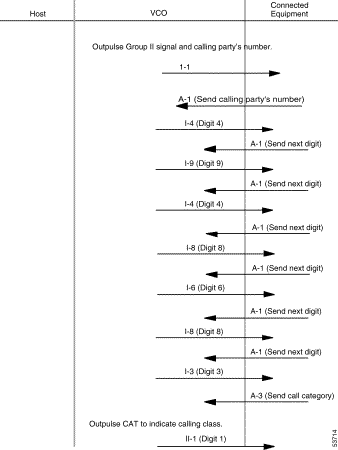
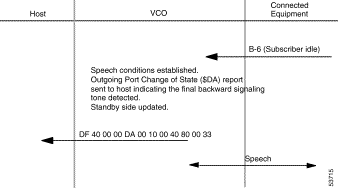
![]()
![]()
![]()
![]()
![]()
![]()
![]()
![]()
Posted: Sat Sep 28 22:11:30 PDT 2002
All contents are Copyright © 1992--2002 Cisco Systems, Inc. All rights reserved.
Important Notices and Privacy Statement.